Centro De Bellas Artes Y Paseo De Las Artes De Caguas
| Caguas barrio-pueblo Pueblo de Caguas | |
|---|---|
| Municipality Seat[ane] | |
 The old Caguas City Hall is a museum | |
 Location of Caguas barrio-pueblo within the municipality of Caguas shown in red | |
| Caguas barrio-pueblo Location of Puerto Rico | |
| Coordinates: 18°14′02″N 66°02′00″W / 18.23393°N 66.033207°W / 18.23393; -66.033207 Coordinates: 18°14′02″Due north 66°02′00″W / xviii.23393°Northward 66.033207°W / 18.23393; -66.033207 [2] | |
| Commonwealth | |
| Municipality | |
| Area [ii] | |
| • Total | 2.67 sq mi (six.ix kmii) |
| • Land | 2.67 sq mi (6.ix km2) |
| • Water | 0 sq mi (0 kmii) |
| Elevation [iii] | 233 ft (71 m) |
| Population (2010) | |
| • Full | 22,406 |
| • Density | 8,391.viii/sq mi (iii,240.1/km2) |
| Source: 2010 Census | |
| Fourth dimension zone | UTC−4 (AST) |
Caguas Pueblo is a barrio and downtown area that serves the administrative center (seat) of the city and municipality of Caguas, a municipality of Puerto Rico. It is bordered past the Cagüitas River to the n and located two miles southwest of the Grande de Loiza River. Its population in 2010 was 22,406.[1] [4] [5] [6]
As was customary in Espana, in Puerto Rico, the municipality has a barrio chosen pueblo (barrio-pueblo starting with the 1990 U.s. Census) which contains a central plaza or primary boondocks square, the municipal buildings (such as the city hall), and a Catholic church. Fiestas patronales (patron saint festivals) are held in the main town square every yr.[seven] [8] The municipal and mayoral offices were located in the City Hall building at the western border of the main boondocks square until 2010 when a new City Hall edifice located in the northwestern side of the downtown area was inaugurated.
Geography [edit]
Caguas Pueblo (Spanish: Pueblo de Caguas), officially designated equally Caguas Barrio-pueblo and popularly referred to as Downtown Caguas in English, is located in the center plains of the Caguas Valley. It is bordered by the Cagüitas River to the n, the Loíza River to the e and the Turabo River to the due south.[9]
History [edit]
The expanse where downtown Caguas is located today was originally inhabited by the Taíno people. This area of the valley was ideal for the cultivation of crops, such as cassava, due to the fertile river-fed soil. At the fourth dimension of the Spanish colonization the local tribes were led by the cacique Caguax, from whom the Spanish settlement of San Sebastián del Piñal de Caguax got its name. This hamlet was granted town privileges in 1812 and its outset city hall was built in 1820 when it received the title of Villa y cabeza de distrito de Provincia de España ("Villa and District headquarters of a Castilian province"). The village was finally granted total urban center rights in 1894.[x]
Puerto Rico was ceded past Spain in the aftermath of the Spanish–American State of war under the terms of the Treaty of Paris of 1898 and became an unincorporated territory of the U.s.. In 1899, the United states Department of War conducted a census of Puerto Rico finding that the population of Caguas Pueblo was 5,450.[11] The surface area was heavily damaged by San Felipe Segundo (also known as the 1928 Okeechobee hurricane) in 1928 and many historical buildings were demolished so, which is why many of the older buildings, such as the cathedral, date from the 1930s later many rebuilding projects in the downtown took place.[ix]
The central plaza and its church [edit]

The primary town square of Caguas is named Plaza de Recreo Santiago R. Palmer . This is i of the largest main town squares or plazas in Puerto Rico. The central plaza or square, is a public space that is ofttimes used for official and unofficial recreational events and is a place where people can gather and socialize from dusk to dawn. The Laws of the Indies, Spanish constabulary, which regulated life in Puerto Rico in the early 19th century, stated the plaza'southward purpose was for "the parties" (celebrations, festivities) (Spanish: a propósito para las fiestas), and that the square should be proportionally large plenty for the number of neighbors (Spanish: grandeza proporcionada al número de vecinos). These Spanish regulations besides stated that the streets nearby should be comfy portals for passersby, protecting them from the elements: sun and pelting.[7]
Located across from the central plaza in Caguas barrio-pueblo is the Catedral Dulce Nombre de Jesús which serves equally the regional Catholic cathedral. A hermitage was built in 1626 and by 1775 it had been renamed to its current name. In 1830 the structure of a church building fabricated of masonry began. The church was used until 1928 when it was damaged past San Felipe Segundo hurricane. Having sustained also much damage, it was demolished and reconstructed starting in 1936 based on an architectural design by Pedro Méndez and Joseph O'Kelly. The church was restored in 1999. In 1964 the church became a cathedral.[12]
| Historical population | |||
|---|---|---|---|
| Demography | Pop. | %± | |
| 1900 | 5,450 | — | |
| 1950 | 33,759 | — | |
| 1980 | 28,729 | — | |
| 1990 | 26,065 | −9.iii% | |
| 2000 | 24,023 | −7.8% | |
| 2010 | 22,406 | −six.7% | |
| U.S. Decennial Census[13] 1899 (shown as 1900)[xiv] 1910-1930[15] 1930-1950[sixteen] 1980-2000[17] 2010[eighteen] | |||
Landmarks and places of interest [edit]
- Aguayo Aldea Vocational High School, historical Art Deco building from 1939 listed on the National Register of Historic Places.
- Caguas Cathedral Dulce Nombre de Jesús, the historical Catholic cathedral of the Diocese of Caguas.
- Caguas Museum of Art, housed in a historic building known as Casa Amarilla.
- Caguas Museum of Folk Arts, defended to the pop arts and crafts of Caguas and Puerto Rico.
- Caguas Museum of History in the old city hall.
- Caguas Museum of Tobacco, dedicated to the history of tobacco in Caguas and the Caribbean.
- Centro Criollo de Ciencias y Tecnología del Caribe, a science and engineering science establishment hosting special educational events, a museum, science and engineering workshops and a movie house.
- Centro de Bellas Artes de Caguas, the municipal center for performing arts which houses one of the largest theaters in Puerto Rico.
- Starting time Baptist Church of Caguas, historic church and museum.
- Gautier Benítez High Schoolhouse, historical Neoclassical building from 1924 also listed on the National Register of Historic Places.
- La Asturiana, a historical bakery and café.
- Las Catalinas Mall, located in the former Central Santa Catalina sugarcane plantation and refinery.
- Logia Unión y Amparo No. 44, historic masonic social club.
- Old Telegraph at the Casa del Rey building adjacent to the urban center hall.
- Panadería La Française, a popular bakery turned into a restaurant (Eiffel Café) and pizza parlor (Farinole Pizza & Bar), popular with locals and visitors akin.
- Paseo de las Artes Abelardo Díaz Alfaro, a promenade located next to the Caguas Center for Performing Arts, popular for its nightlife and social events.
- Paseo Gautier Benítez, a pedestrian street with stores, restaurants and bars.
- Plaza del Mercado de Caguas, the city's main marketplace which today houses nutrient stores, restaurants, private offices and often hosts cultural events.
- Plaza Juan Corujo Collazo, a modest square and recreational park.
- Taíno Heritage Monument, popularly known as La India de Caguas.
Gallery [edit]
Places in Caguas barrio-pueblo:
-

Carousel in Plaza Palmer (main town square) and the cathedral in the dorsum
-

New Caguas City Hall
-
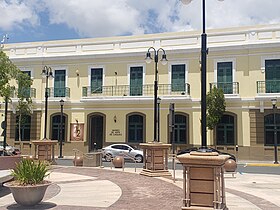
Caguas Museum of Art
-
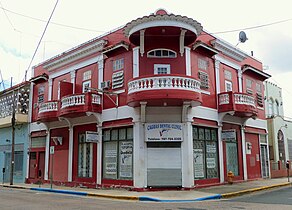
Typical architecture
-

-
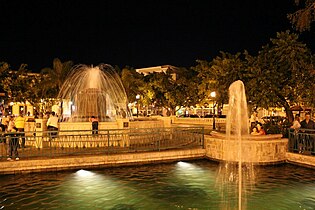
Fountain in Plaza Palmer.
-
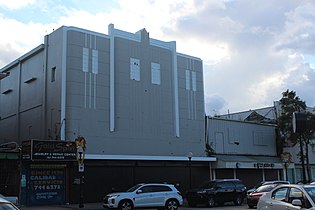
Old Caguas theater.
-

The former Telegraph building of Caguas.
-

Dr. Pedro Albizu Campos Public Library and Caguas Historical Archives
-

-
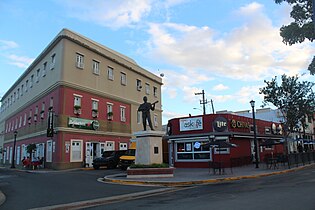
Padial Street
-
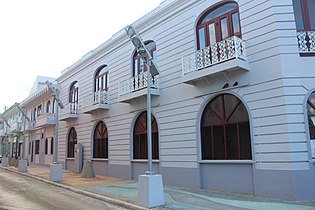
Historic bank edifice in Plaza Palmer
See too [edit]
- List of communities in Puerto Rico
References [edit]
- ^ a b Puerto Rico:2010:population and housing unit of measurement counts.pdf (PDF). U.Southward. Dept. of Commerce, Economics and Statistics Administration, U.S. Census Bureau. 2010.
- ^ a b "United states Gazetteer 2019". Us Census. The states Government.
- ^ U.S. Geological Survey Geographic Names Information System: Caguas barrio-pueblo
- ^ Picó, Rafael; Buitrago de Santiago, Zayda; Berrios, Hector H. Nueva geografía de Puerto Rico: física, económica, y social, por Rafael Picó. Con la colaboración de Zayda Buitrago de Santiago y Héctor H. Berrios. San Juan Editorial Universitaria, Universidad de Puerto Rico,1969.
- ^ Gwillim Law (20 May 2015). Administrative Subdivisions of Countries: A Comprehensive World Reference, 1900 through 1998. McFarland. p. 300. ISBN978-1-4766-0447-3 . Retrieved 25 Dec 2018.
- ^ "The states Census Barrio-Pueblo definition". factfinder.com. United states Census. Archived from the original on 13 May 2017. Retrieved 5 Jan 2019.
- ^ a b Santullano, Luis A. (10 March 2019). Mirada al Caribe. Vol. 54. Colegio de Mexico. pp. 75–78. doi:10.2307/j.ctvbcd2vs.12. JSTOR j.ctvbcd2vs.12.
- ^ Pariser, Harry Southward. (2003). Explore Puerto Rico, Fifth Edition . San Francisco: Manatee Press. pp. 52–55. Retrieved 10 Feb 2019.
- ^ a b Katia, de Lamadrid Pesant (1991). Caguas: Transformaciones territoriales desde el período colonial hasta 1952 (in Spanish). Universidad del Turabo.
- ^ Samame, Juan Carlos. "Historia". Municipio de Caguas . Retrieved 2021-10-19 .
- ^ Joseph Prentiss Sanger; Henry Gannett; Walter Francis Willcox (1900). Informe sobre el censo de Puerto Rico, 1899, United states of america. State of war Dept. Porto Rico Demography Office (in Spanish). Imprenta del gobierno. p. 162.
- ^ Mari Mut, José A. (2013-08-28). Los Pueblos de Puerto Rico y Las Iglesias de Sus Plazas [The Pueblos of Puerto Rico, and the Churches of its Plazas] (PDF) (in Castilian). pp. 46–48. Archived (PDF) from the original on 2020-12-14. Retrieved 2021-07-29 .
- ^ "U.S. Decennial Demography". United states of america Census Bureau. Archived from the original on Feb 13, 2020. Retrieved September 21, 2017.
- ^ "Study of the Demography of Porto Rico 1899". War Department Office Managing director Census of Porto Rico. Archived from the original on July sixteen, 2017. Retrieved September 21, 2017.
- ^ "Tabular array 3-Population of Municipalities: 1930 1920 and 1910" (PDF). United States Census Agency. Archived (PDF) from the original on August 17, 2017. Retrieved September 21, 2017.
- ^ "Table 4-Area and Population of Municipalities Urban and Rural: 1930 to 1950" (PDF). The states Demography Bureau. Archived (PDF) from the original on August 30, 2015. Retrieved September 21, 2014.
- ^ "Table two Population and Housing Units: 1960 to 2000" (PDF). United States Census Agency. Archived (PDF) from the original on July 24, 2017. Retrieved September 21, 2017.
- ^ Puerto Rico:2010:population and housing unit counts.pdf (PDF). U.S. Dept. of Commerce Economics and Statistics Administration U.S. Census Bureau. 2010. Archived (PDF) from the original on 2017-02-xx. Retrieved 2019-08-02 .
Source: https://en.wikipedia.org/wiki/Caguas_barrio-pueblo

إرسال تعليق for "Centro De Bellas Artes Y Paseo De Las Artes De Caguas"